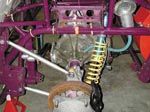
What is the best way to get your dirt Late Model to stick to the track and perform in a winning manner? Circle Track Maga-zine went to Keith Nosbish’s race shop in Valrico, Florida, to find out. Nosbish races a dirt Late Model in the Southeast Motorsport series in Florida and at East Bay Raceway in Tampa. He comes from a family of racers, including his father, two brothers, and nephew. We also spoke with Mark Richards, manufacturer of Rocket Chassis, to learn some tips that will help every dirt Late Model racer.
“The track goes through different stages—from being heavy, loose dirt, to being packed with an asphalt- like feel as the races progress during the day,” Nosbish explains. Because of this, there is a need for constant change to the race car’s suspension to keep it on the track and be competitive with the other racers.
Here are several crucial tuning tips supplied by both Nosbish and Richards to help you get around the track faster than your opponent:
1 When you set up a modern dirt Late Model, it is best to start with the recommendations from the chassis builder, then adjust from there. This will assure positive results more quickly.
2 Analyze your handling problems correctly. You won’t help matters by fixing a misdiagnosed problem, so think through your problems before you make changes.
3 Don’t tune too tight. This can cause your race car to get too much traction and understeer. A common error with tuning too tight is that the driver may overcompensate in the turns, which gives the car a loose feel. This can result in a misdiagnosis and an incorrect adjustment.
4 Make sure you factor in tire choices when making adjust-ments. Proper tire compound, con-struction, and air pressure is a critical part of handling.
5 Be careful not to overadjust any suspension component; this can produce an effect that is the opposite of what is desired.
6 Make changes in one area at a time, so you can understand what you did and how it affected the race car. Making multiple changes is a shot-in-the-dark approach that usually nets poor results.
7 Shock tuning has become extremely important to help make a race car handle properly. Double-adjustable shocks make it easier to accomplish this part of tuning.
8 When running at a stop-and-go–type of dirt track, a tighter suspension is usually best.
9 When running a big-momentum type of dirt track, a looser or freer type of setup will usually help you run faster.
10 database with accurate records of all your race car’s changes and results will help eliminate continual trial and error. Include track information for better results.